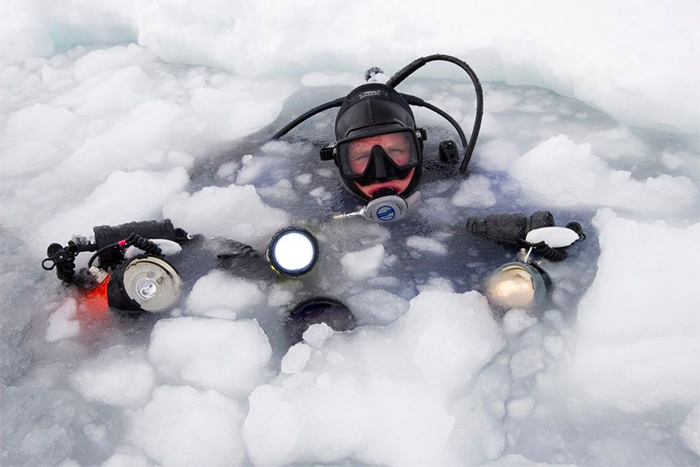
Eyck Freymann: How to Break China’s Minerals Chokehold
Why the allies need a multilateral commercial stockpile This essay is based on a Hoover History Lab working paper, co-authored with Joshua Stinson, William Norris,…
Thought Leader: Eyck Freymann

Every picture tells two stories, the one in front of the lens and the one behind the camera. The one behind the camera is not always so obvious, but it can be just as dramatic — and telling. This is a story of adventure and misadventure, a story of how I got into serious trouble while diving under the ice in the Beaufort Sea early in my National Geographic career.
The year was 2003. I was on assignment for a story about changing sea ice conditions in the Arctic — this was nearly 20 years ago, remember — and I had been invited aboard the Canadian Coast Guard Ship Louis S. St-Laurent as part of a six-week scientific research expedition.

Scientists being lowered to the sea ice.
In my work, I have always tried to find the intersection between art, science, and conservation. On this occasion, I felt both the need and an obligation to transport National Geographic readers vicariously deep beneath the sea ice, to show them a living world that survives underneath ice that is 12 feet thick in places. There is an entire community that lives on the underside of that ice, and I wanted to capture that on film.
Sea ice is like the soil in a garden. Think of it as an inverted garden, a “garden of the sea,” where luminous zooplankton feed on phytoplankton and polar cod dart in and out of layers of ice, looking for copepods and amphipods (krill-like crustaceans). It’s a glorious sight to behold, and it speaks to the beauty and vitality of the natural world.

Polar cod dart in and out of layers of ice.
Based on sea ice measurements taken in the 1970s by Russian submarines, we knew by 2003 the sea ice had thinned by some 50%, and I wanted to show that in visual terms that anyone could understand.
This was during a time when climate scientists were reluctant to use words like “global warming,” “carbon emissions,” and “climate change” for fear of being dismissed and mocked as hand-wringing alarmists by their detractors. Everyone was cautious. The scientists onboard viewed this from the scientific approach of, Let’s see what’s going on and collect data, as any good, careful scientist does.

Jeremy Stewart looking for life under thick chunks of multi-year ice.
It was a long and arduous process to convince the Canadian government, Coast Guard, and Department of Fisheries and Oceans to grant permission for my team to dive below the ice, but eventually they agreed.
I knew I had to make the effort, though, if I was to have half a chance of coming back with strong, meaningful images — a fact National Geographic constantly reminded us of.

Jeremy Stewart, an employee of DFO at the time uses a suction pump to collect zooplankton from the bottom of the sea ice for the scientists waiting on the sea ice 6 feet above us. Our safety lines were always getting tangled around us.
Diving below sea ice is a complicated process that requires considerable patience, resilience and experience. Much of that comes from a lifetime of diving in challenging conditions.
And, of course, luck is needed as well. I didn’t realize it at the time but it would be the last of these — luck — that would prove to be the difference between my being here today to tell this story and, well, the alternative.
One tug means everything is fine. Two tugs mean you need more line, so you can continue your descent. Three tugs mean pick up slack in the line, so your line is always taut. And four tugs mean Help!
In normal circumstances, that system of communication works just fine.
On this occasion, I was at the end of a 150-foot safety line in 29°F (—1°C) water, with little more than a third of my air left, and I was on my way back to the ice edge. So far, so good — but then strong underwater currents began to push the 450-foot-long icebreaker, all 15,000 tons of it, up against the edge of the ice where I had entered the water, blocking my exit.

The Louis St Laurent smashing its way across the Northwest Passage.
Nowadays, the ice has diminished to the point that small plastic sailboats and inflatable boats making their way across the NW passage without encountering much ice at all.
Icebreakers don’t break the ice with their bow, as many people think. Instead, they ride up on the ice and then blow blasts of air under the surface, causing the weight of the ship to flatten the ice and shatter it through sheer force.To break free, the icebreaker had to use its bow thruster — a pipe three to four feet in diameter that discharges thousands of cubic meters of compressed air with each blast.
The icebreaker fired a blast of air, and all I could see was this white wall of air coming at me in a great rush, and the next thing I knew, I was being blown back under the ice.
I kicked harder and harder, burning through my remaining air supply, and in a quick moment, I checked it and realized: I’m in trouble.
– To Be Continued –
Eyck Freymann: How to Break China’s Minerals Chokehold
Why the allies need a multilateral commercial stockpile This essay is based on a Hoover History Lab working paper, co-authored with Joshua Stinson, William Norris,…
Thought Leader: Eyck Freymann
Chris Miller: Robotics Manufacturing: The Rise of Japan
“To the Americans, a robot is a computer attached to a mechanism. To Japanese, a robot is a mechanism attached to a computer.” The future…
Thought Leader: Chris Miller
Dr. Sanjay Gupta: A New Understanding of Parkinson’s Disease
Parkinson’s disease, a progressive movement disorder whose hallmark is damage to the dopamine-producing neurons in the brain, afflicts almost 12 million people worldwide. And the…
Thought Leader: Sanjay Gupta

